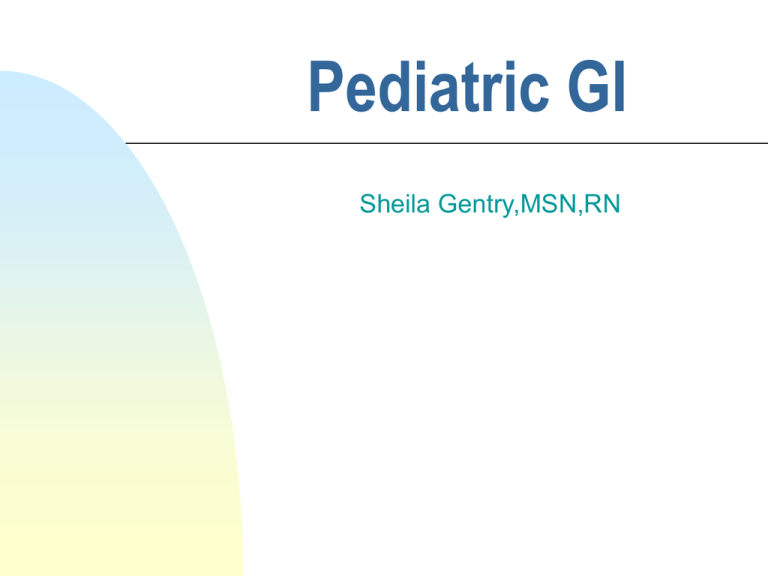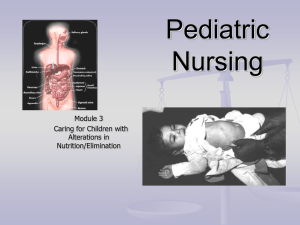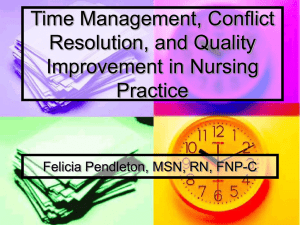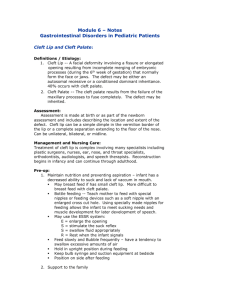
Pediatric GI
Sheila Gentry,MSN,RN
Development
Begins 3rd week of gestation
Mouth to Anus
Includes
the liver, gallbladder and
pancreas
Mouth
Esophagus
Stomach
Small intestines
Large intestines
Rectum
Function
Digestion and absorption of
nutrients and water, secretion of
substances and elimination of
waste products
Digestion:
circular muscles churn
and mix food. Longitudinal muscles
propel the food bolus. And
sphincter muscles control passage
of food
Enzymatic activity: aids in
breakdown of foods
General Assessment
Assess pain(seven variables)
Normal bowel habit
Assess for changes in appetite
Identify thirst level
Food intolerance
Belching, vomiting, heartburn,
flatulence
Identify routine eating habits
Ask about PMH related to GI
Height/Weight
Hydration status
I, A, P, P of abdomen
Common Diagnostic
Studies
Blood chemistries, liver profile, sed
rate, C-reactive protein, thyroid
function
Stool exams for ova and parasites,
blood, WBC’s, pH, cultures, fecal
fat collection(72 hr test to r/o fat
malabsorption)
Bowel studies: UGI, BE, biopsy,
rectosigmoidoscopy, Abd. Xrays.
US of abdomen and pelvis
Congenital GI Anomalies
Cleft lip/palate
Esophageal atresia
Tracheoesophageal fistula
Omphalocele
Gastroschisis
Pyloric stenosis
Imperforate anus
Celiac disease
Hirshsprung’s disease
Intussusception
Hernia’s
Cleft Lip
Affects 1 in 800. More common in boys
Etiology: hereditary, environmental,
teratogenic factors. Occurs around 7
weeks gestation
Readily apparent
Degree affected may vary. Small notch
to complete separation
Surgical closure 1-2 months or Rule of
10
Cleft Palate
1-2800 affected. More girls affect
Occurs at about 9 weeks gestation
May involve soft palate alone to
hard palate /more severe maxilla
Surgical repair between 6-18mo.
Will have long-term care with HCP
Plastic surgeon, ENT, Nutritionist,
Speech Therapy, Orthodontist,
Pediatrician
Major Nursing
Diagnoses
Ineffective airway clearance
Alt. Nutrition-LBR
Potential for Alt. in parenting
Risk for infection
Pain
Management /Nursing
Care
Pre-op
Assess degree of cleft
Assess Respiratory status
Assess ability to suck(will see difficulty
with sucking and swallowing)
Assist with feeding: head upright/special
nipples/ESSR
Continuous monitoring during feeding
Remove oral secretions carefully
Reaction of parents-guilt,
disappointment, grief, sense of
loss, anger. Encourage
verbalization of fears/concerns
Encourage bonding/touching
Inform parents of successful
surgical intervention
Nursing Care Post-Op
Maintain patent airway. Lung
assessment before/after feeding
Cleft lip proper positioning
Cleft palate-side or abdomen
Upright, or on unaffected side. Never
prone
Liquids from side of cup or spoon
NO ORAL TEMPS
No straws, pacifiers, spoons, or fingers
around mouth for 7-10 days
Encourage family participation in care
PROTECT SURGICAL SITE!!!
Elbow
restraints
Minimize crying
Maintain Logan Bow if applied
No toothbrushes 1-2 weeks
Monitor site for infection
Assess pain
Resume feedings as ordered
Care of site after feeding
Esophageal Atresia with
Tracheoesophageal
Fistula
Congenital anomalies rare
Clinical and Surgical Emergency
Assessment
Three C’s of TEF
Choking, coughing, cyanosis
Plain water at birth
Management/Nursing Care
Surgical correction(thoracotomy)
Monitor Resp. status
Monitor/Remove excessive secretions
Elevate infant into anti-reflux
position 30 degree incline
Provide O2
NPO(non-nutritive sucking ok)
IVF’s
Provide gastrostomy care/feedings
Education/Family involved in care
Pyloric Stenosis
Assessment
Characteristic
projectile vomiting(bile
free)
Hungry, fretful, irritable,dehydration
Weight loss/failure to gain weight
Metabolic alkalosis
Palpable olive-shaped mass in RUQ
Diagnosis: US/UGI delayed
emptying and elongated pyloric
canal
May require surgical intervention:
Pyloromyotomy
Nursing Care
Monitor respiratory status
Hydration status
IVF’s, electrolytes, NG tube care, Daily
WT, I/O hrly , small frequent
meals(clears)NPO prior to surgery.
4-6hrs. After surgery may begin small
frequent feeding with lytes solution or
glucose
Place on R side/Semi-Fowler’s
after feeding
Burp frequently
Congenital/Aganglionic
Megacolon
Also called Hirshsprung’s Disease
Congenital 1 in 500
Absence
of parasympathetic
ganglion cells in distal portion of
colon and rectum
Lack of peristalsis
Fecal contents accumulate
Mechanical obstruction
Management/Nursing
Care
Correction- series of surgical
intervention(Temporary colostomy with
reanastamosis and closure later)
Pre-op care
Post-op care
Same
as for any abdominal surgery
NPO
Routine
ABC’s (axillary temps)
Monitor colostomy..note stoma color
Monitor
bowel function, abdominal
circumference
Teach family ostomy care
Toilet-training after age 2
Intussusception
Telescoping of a portion of bowel into
another(usually ileum to colon)
Partial or complete bowel obstruction.
May require Emergency Surgery
Assessment
Usually infant under 1 yr.
Parent may relay acute, intermittent
abdominal pain
Child may present screaming with legs drawn
up
Management/Nursing
Care
Vomiting
“Currant Jelly” stools
Sausage shaped mass in RUQ while
RLQ is empty(Dance sign)
Management/Nursing Care
Medical treatment: Barium enema
Monitor VS
Monitor for shock or bowel perforation
IVF’s, I/O, prepare child for barium
enema…monitor stools pre/post BE
Anorectal Malformations
Congenital
Surgical repair based on extent
Imperforate Anus
Will
see unusual anal dimpling
No passage of meconium
Meconium appearing from perianal
fistula or in urine
Suspicion in newborn for failure to
pass meconium in 24 hrs
Or if emesis is bile stained
Abdominal assessment
Chronic constipation in toddlers
May alt. With diarrhea
“Ribbon-like” stools. Foul-smelling
Management/Nursing
Care
Requires surgical correction
Discovered with newborn 1st temp
rectally
Assess
passage of meconium
Assist family to cope with dx
Will usually see other high-level
defect
Celiac Disease
Genetic: Inability to tolerate foods with
gluten(wheat, barley, rye, oats)
Life-long dietary modification
Diagnosis: Biopsy
Celiac crisis
Assessment
symptoms appear 3-6mo. After
introduction of gluten(grains)
frequent bulky, greasy, malodorous
stools with frothy appearance
(Steatorrhea) 72 hr.fecal fat study
Management/Nursing
Care
Gluten
free diet
Read labels
Hernias
Protrusion of an organ through
abnormal opening
Results in organ constriction and
impaired blood flow
Diaphragmatic
Hiatal
Abdominal
Diaphragmatic Hernia
Congenital
Abdominal content protrude into thoracic
cavity through an opening in the
diaphragm
Findings depend on severity
diminished/absent breath sounds
bowel sound may be heard over chest
Cardiac sounds may be heard on
right side of chest
Dyspnea, cyanosis, nasal flaring,
retractions, sunken abdomen and
barrel chest
Management/Nursing
Care
Surgical correction
Medical emergency
Chest tubes
Maintain airway(ventilator)ECMO
HOB^ Position on affected side
NG tube
IVF
Post-op
Monitor for infection, respiratory distress
Activities to promote lung function
Hiatal
Sliding
Protrusion
of abdominal
structure(stomach) through the
esophageal hiatus
Management/Nursing
Care
Depends on severity
Diagnosis: Fluoroscopy
Assessment
See dysphagia, Failure to thrive,
vomiting, GER
Nursing care:
HOB elevated
Small frequent feedings
Manage GER symptoms
Monitor respiratory status pre/post
feedings
Umbilical Hernia
Soft, skin covered protrusion of
intestine around umbilicus
See in premature infants and
African American infants more
often
Spontaneous closure 3-4 (most by
1yr.)
Management/Nursing
Care
Surgical repair if >1.5-2cm or if not
spontaneously closed by age 2
May be reduced with a finger
Nursing Care:
Monitor for change in size or for
incarceration(hyperactive bowel sounds
or inability to reduce)
Education
Binding not effective
Discourage home remedies
Omphalocele and
Gastroschisis
Omphalocele:
abdominal contents herniate through the
umbilical cord
Covered with translucent sac
Gastroschisis:
bowel herniates through defect in
abdominal wall. Usually to the right of the
umbilicus
No covering of on exposed bowel
Degree is varied in both
Management/Nursing
Care
Surgical Repair necessary
Nursing Care:
Will be obvious @ delivery
Caution not to rupture sac
Place in warmer immediately
Sterile treatment
Immediately cover with sterile gauze
saturated with warm saline and wrap with
plastic
Minimize movement of the infant and
handling of sac
Continuous temperature
monitoring
ABC’s
NG tube
Wt, I/O, IVF’s, TPN as ordered
Monitor for signs of ileus…
Assess parents coping, encourage
grieving, and parental participation
in care, refer to support group
Biliary Atresia
Unknown cause
Intrahepatic and extrahepatic bile
duct obstruction
Liver becomes fibrotic, cirrhosis
and portal HTN develops..Leads to
Liver Failure and death without
treatment
Surgical(Kasai procedure)
temporary measure
Liver Transplant
Healthy @ birth
Jaundice --2 weeks to 2 month
Acholic stools
^Bilirubin
Abdominal distention
Hepatomegaly
^bruising ^ PT
Intense itching
Tea-colored urine
Infections
Thrush
Acute Gastroenteritis
Appendicitis
Pinworms
Thrush
Monilial (yeast) infection of mouth
May or may not have symptoms
White coating in oral cavity
Fussy and gassy
Treatment:
If breast fed: treat mother and baby
Anti-fungal cream to nipples after feeding
Nystatin orally x 7 days
Careful hand washing to prevent spread
Gastroenteritis
Vomiting/Diarrhea
Common in childhood, usually selflimiting
No specific treatment
Management/Nursing
Care
Prevent dehydration
Assessment
Note onset/ ALWAYS inquire about
associated signs/symptoms
Color
Green-think bile obstruction
Curded, stomach contents several hrs.
after eating-think delayed gastric emptying
Coffee ground- think GI bleeding
Nursing Care
Monitor hydration status/ IVF’s
Vital signs/ no rectal temps
Daily wts, I/O, weigh diapers,
Diet: NPO, Pedialyte 1-3 tsp q 1015 minutes, clear to bland, milk
free. Progress to BRAT diet
No juices, carbonated drinks, or
caffeine
Standard precautions
Appendicitis
Most common reason for surgery in
childhood
Diagnosis: US show incompressible
appendix
CBC..^ WBC’s and left shift/symptoms
Treatment: Surgical removal
Assessment Findings:
Abdominal pain/rebound tenderness/
peri-umbilical pain
N/V, fever, chills, anorexia, diarrhea or
acute constipation
Management/Nursing
Care
Pre-op care
NPO, IVF’s,Permit
Semi-Fowler’s or right side lying
Do nothing to stimulate peristalsis
No heat application
Sudden relief of pain…BAD
Post-op care
VS
Monitor for abdominal distention, wound
care, ambulation within 6-8h, T, C, DB
Pain assessment
D/C education
Necrotizing Enterocolitis
Cause: intestinal ischemia,
bacterial or viral infection, and
premature birth
Onset: first 2 weeks of life
Diagnosis: Xray- dilated bowel
loops/thickening or free air(Medical
Emergency)
Assessment
History prematurity, SGA, maternal
hemorrhage, preeclampsia, or
umbilical catheter
Stage I: nonspecific findings that
may represent physiologic
instability
Stage II: nonspecific findings +
severe
abdominal distention, abd.
Tenderness, gross bloody stools,
absent bowel sounds and palpable
bowel loops
Stage III: Acutely ill, Septic shock,
DIC, Death
Pinworms
Enterobiasis
Caused
by a nematode
It is the most common helminthic
infection
Eggs ingested or
inhaled..hatch/mature in upper
intestine..then migrate through the
intestine to mate and lay eggs at
the anal opening
Management/Nursing
Care
Symptoms
Intense
Diagnosis:
Tape
anal pruritis
test early AM
DOC:
Vermox
if >2yrs of age
Treat entire family
Hepatitis
Same as in adult
A,B,C,D,E
Anicteric phase 5-7 days
Icteric phase last up to 4 weeks
Hep A Control spread(standard
precaution)
Hep B prevent with vaccine
Failure to Thrive
IBW falls below 5th percentile on
growth charts
Organic:
Non-organic
Gastroesophageal
Reflux
Typically self-limiting by 1 yr
Severe may require surgery
Nissenfundoplication
Assessment
frequent
vomiting, melena,
hematemesis, hiccuping, heartburn
and abdominal pain
Management/Nursing
Care
keep
upright, rice cereal added to
formula, no fatty foods or citrus
juices
Asses breath sounds before and
after feeding
Suction @ bedside
Prone head elevated after feeding
avoid placing in infant seat
administer meds: Antiacids, H2
blockers,
Assess hydration
I/O, Monitor IVF’s, Daily weights
Small frequent feedings
Solids first then liquids
Burp often
Monitor for dumping syndrome 30
minutes after feeding (if post-op)
Constipation/Encopresis
Three or more days without BM
Painful BM’s
Encopresis is fecal soiling or
incontinence
Can be secondary to GI disorder,
certain medications or
psychosocial factors
Management/Nursing
Care
Investigate cause
Promote regular bowel movement
Increase fiber and fluid in diet
Stool softeners
Provide a non-threatening
environment
Do not push child during training
Fluid and Electrolyte
Imbalance
Infants and younger children have
greater need for water and are
more vulnerable to alterations
Greater BSA(body surface area)
Increased BMR(basal metabolic
rate)
Decreased kidney function
(immaturity)
Fluid requirements depend of
hydration status, size of
infant/child,environmental factors
and underlying disease
Management/Nursing
Care
Daily maintenance based on
weight in kilograms
ml/kg for 1st 10 kg
50 ml/kg for 2nd 10 kg
20 ml/kg remaining of kg
100
Then divide total amount by 24 hrs
This will be the rate in ml/hr
Nursing Care:
Be alert to potential problems
Accurate I&O’s are vital
Daily weights
Weigh diapers
Assess mucous membranes,
fontanels
Poisoning/Foreign
Bodies
Major health concern
Most occur in children less than 6
90% occur in the home
Most commonly ingested poisons
Cosmetic
products
Cleaning products
Plants
Foreign body ( toys, batteries)
Gasoline
Management/Nursing
Care
Emergency treatment may or may
not be necessary
Assess victim
Terminate exposure
Identify poison
Call poison control
Remove poison/Prevent absorption
Syrup
of Ipecac
Do not induce vomiting if patient
has absent gag reflex
Or if poison is corrosive
Place child in side-lying, sitting or
kneeling position
Administer activated charcoal with
cathartic usual dose 1gm/kg
Education: PREVENTION is key…
Colic
Persistent abdominal pain
characterized by loud crying,
drawing up legs to abdomen
lasting greater than 3 hrs.
Common in infants less than 3
months
Possible causes
Too
rapid feeding, excessive air
Overeating, milk allergy
Parental tension, or smoking
Management/Nursing
Care
Try to identify causative agent
Medications: Atarax and
Simethicone
Obtain detailed diet history of baby
and mother if breast baby
Try to identify relationships to
crying episodes
Parental coping











